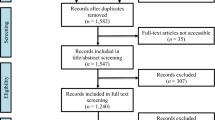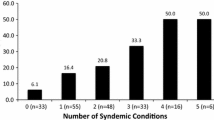Abstract
Research on internalized homophobia (IH) has consistently linked it to both mental and physical health outcomes, while research on its relationships with other variables has been inconsistent. Some research and theory support the association between IH and risky sexual behavior, but much of this research has been plagued by methodological issues, varying measures, and has produced inconsistent findings. Coming to a better understanding of the utility of IH as a potential mechanism or predictor of risky sex in men who have sex with men (MSM) may help to inform future studies of HIV risk in this population as well as the development of prevention interventions. The current study used hierarchical linear modeling to perform meta-analysis combining effect sizes across multiple studies of the relationships between IH and risky sexual behavior. Additionally, the use of multilevel modeling techniques allowed for the evaluation of the moderating effects of age, year of data collection, and publication type on this relationship. Sixteen studies were meta-analyzed for the relationship between IH and risky sexual behavior (N = 2,837), revealing a small overall effect size for this relationship. However, a significant moderating effect was found for the year of data collection, such that the correlation between these two variables has decreased over time. The current utility of this construct for understanding sexual risk taking of MSM is called into question.
Similar content being viewed by others
References
Allport, G. (1954). The nature of prejudice. Reading, MA: Addison-Wesley.
Brooks, V. (1981). Minority stress and lesbian women. Lexington, KY: Lexington Press.
Broverman, N. (2006, February 14). By the numbers: Gay rights. The Advocate, 36.
Centers for Disease Control and Prevention. (2004a). Cases of HIV infection and AIDS in the United States, 2004. Atlanta, GA: United States Department of Health and Human Services.
Centers for Disease Control and Prevention. (2004b). Trends in reportable sexually transmitted diseases in the United States: National data on chlamydia, gonorrhea and syphilis. Atlanta, GA: United States Department of Health and Human Services.
Centers for Disease Control and Prevention. (2008). HIV prevalence estimates-United States, 2006. Morbidity and Mortality Weekly Report, 57, 1073–1076.
Currie, M. R., Cunningham, E. G., & Findlay, B. M. (2004). The Short Internalized Homonegativity Scale: Examination of the factorial structure of a new measure of internalized homophobia. Educational and Psychological Measurement, 64, 1053–1067.
Dew, B. J., & Chaney, M. P. (2005). The relationship among sexual compulsivity, internalized homophobia, and HIV at-risk sexual behavior in gay and bisexual users of Internet chat rooms. Sexual Addiction & Compulsivity, 12, 259–273.
DiPlacido, J. (1998). Minority stress among lesbians, gay men, and bisexuals: A consequence of heterosexism, homophobia, and stigmatization. In G. Herek (Ed.), Stigma and sexual orientation (pp. 138–159). Thousand Oaks, CA: Sage Publications.
Drumwright, L. N., Patterson, T. L., & Strathdee, S. A. (2006). Club drugs as causal risk factors for HIV acquisition among men who have sex with men: A review. Substance Use & Misuse, 41, 1551–1601.
Dudley, M. G., Rostosky, S. S., Korfhage, B. A., & Zimmerman, R. S. (2004). Correlates of high risk sexual behavior among young men who have sex with men. AIDS Education and Prevention, 16, 328–340.
Farnsworth, T. O. (2003). The relationship of internalized homophobia, religiosity, and self-destructive behaviors in self-identified gay men. Dissertation Abstracts International, 63, 5512.
Garofalo, R., & Mustanski, B. (2005). [The relationship between internalized homophobia, psychological distress and sexual behavior in LGB youth]. Unpublished raw data.
glsen.org. (2007). As students return to school, more than 3,600 GSAs now registered with GLSEN. Retrieved June 19, 2009, from http://www.glsen.org/cgi-bin/iowa/all/news/record/2216.html
Goldberg, D. A. (1989). A study of the influence of self esteem, internalized homophobia, safer sex knowledge, and anxiety on sexual satisfaction in single gay males practicing safer sex. Dissertation Abstracts International, 50, 1645.
Gonsiorek, J. (1988). Mental health issues of gay and lesbian adolescents. Journal of Adolescent Health Care, 9, 114–122.
Higgins, D. (2002). [The relationship between internalized homophobia and risky sexual behavior in gay men previously in heterosexual marriages]. Unpublished raw data.
Huebner, D. M., Davis, M. C., Nemeroff, C. J., & Aiken, L. S. (2002). The impact of internalized homophobia on HIV preventive interventions. American Journal of Community Psychology, 30, 327–348.
Jurek, M. R. (1999). Psychosocial factors predicting high risk sexual behavior in HIV-negative gay men (immune deficiency). Dissertation Abstracts International, 60, 2947.
Kashubeck-West, S., & Szymanski, D. M. (2008). Risky sexual behavior in gay and bisexual men: Internalized heterosexism, sensation seeking, and substance use. The Counseling Psychologist, 36, 595–614.
Lipsey, M. W., & Wilson, D. B. (2001). Practical meta-analysis. Thousand Oaks, CA: Sage Publications.
Loftus, J. (2001). America’s liberalization in attitudes toward homosexuality, 1973 to 1998. American Sociological Review, 66, 762–782.
Mayfield, W. (2001). The development of an internalized homonegativity inventory for gay men. Journal of Homosexuality, 41, 53–76.
Meyer, I. H. (1995). Minority stress and mental health in gay men. Journal of Health and Social Behavior, 36, 38–56.
Meyer, I. H. (2003). Prejudice, social stress, and mental health is lesbian, gay, and bisexual populations: Conceptual issues and research evidence. Psychological Bulletin, 129, 674–697.
Meyer, I. H., & Dean, L. (1995). Patterns of sexual behavior and risk taking among young New York City gay men. AIDS Education and Prevention, 7(Suppl), 13–23.
Meyer, I. H., & Dean, L. (1998). Internalized homophobia, intimacy and sexual behaviour among gay and bisexual men. In G. Herek (Ed.), Stigma and sexual orientation (pp. 160–186). Thousand Oaks, CA: Sage Publications.
Newcomb, M. E., & Mustanski, B. (2009). Internalized homophobia and mental health: A meta-analytic review. Unpublished manuscript, University of Illinois at Chicago.
Nungesser, L. (1983). Homosexual acts, actors, and identities. New York: Praeger.
Preston, B. P., D’Augelli, A. R., Cassab, C. D., Cain, R. E., Schulze, F. W., & Starks, M. T. (2004). The influence of stigma on the sexual risk behavior of rural men who have sex with men. AIDS Education and Prevention, 16, 291–303.
Preston, B. P., D’Augelli, A. R., Cassab, C. D., & Starks, M. T. (2007). The relationship of stigma to the sexual risk behavior of rural men who have sex with men. AIDS Education and Prevention, 19, 218–230.
Ratti, R., Bakeman, R., & Peterson, J. L. (2000). Correlates of high-risk sexual behaviour among Canadian men of South Asian and European origin who have sex with men. AIDS Care, 12, 193–202.
Raudenbush, S. W., & Bryk, A. S. (2002). Hierarchical linear models: Applications and data analysis methods (2nd ed.). Thousand Oaks, CA: Sage Publications.
Rosario, M., Hunter, J., Maguen, S., Gwadz, M., & Smith, R. (2001). The coming-out process and its adaptational and health-related associations among gay, lesbian, and bisexual youths: Stipulation and exploration of a model. American Journal of Community Psychology, 29, 133–160.
Rosario, M., Scrimshaw, E. W., & Hunter, J. (2006). A model of sexual risk behaviors among gay and bisexual men: Longitudinal associations of mental health, substance abuse, sexual abuse, and the coming-out process. AIDS Education and Prevention, 18, 444–460.
Ross, M. W., & Rosser, B. R. (1996). Measurement and correlates of internalized homophobia: A factor analytic study. Journal of Clinical Psychology, 52, 15–21.
Russell, G. M., & Bohan, J. S. (2006). The case of internalized homophobia: Theory and/as practice. Theory & Psychology, 16, 343–366.
Savin-Williams, R. C. (2008). Then and now: Recruitment, definition, diversity, and positive attributes of same-sex populations. Developmental Psychology, 44, 135–138.
Savin-Williams, R. C., & Ream, G. L. (2007). Prevalence and stability of sexual orientation components during adolescence and young adulthood. Archives of Sexual Behavior, 36, 385–394.
Seibt, A. C., Ross, M. W., Freeman, A., & Krepcho, M. (1995). Relationship between safe sex and acculturation into the gay subculture. AIDS Care, 7(Suppl 1), S85–S88.
Shidlo, A. (1994). Internalized homophobia: Conceptual and empirical issues in measurement. In B. Green & G. Herek (Eds.), Lesbian and gay psychology: Theory, research, and clinical applications (pp. 176–205). Thousand Oaks, CA: Sage Publications.
Stevens, B. C. (2006). Self-reported versus implicit predictors of high-risk sexual behavior among men who have sex with men. Dissertation Abstracts International, 66, 6295.
Szymanski, D. M., Kashubeck-West, S., & Meyer, J. (2008). Internalized heterosexism: Measurement, psychosocial correlates, and research directions. The Counseling Psychologist, 36, 525–574.
White, S. L. (2004). Predictors for readiness to engage in low-risk HIV behaviors in men who have sex with men. Dissertation Abstracts International, 65, 426.
Williamson, I. R. (2000). Internalized homophobia and health issues affecting lesbians and gay men. Health Education Research, 15, 97–107.
Wright, E. R., Dye, J. D., Jiles, M. E., & Marcello, M. K. (1999). Empowering gay, lesbian and bisexual youth: Findings from the Indiana youth access project (Final evaluation report). Unpublished manuscript, Indiana University.
Author information
Authors and Affiliations
Corresponding author
Rights and permissions
About this article
Cite this article
Newcomb, M.E., Mustanski, B. Moderators of the Relationship Between Internalized Homophobia and Risky Sexual Behavior in Men Who Have Sex with Men: A Meta-Analysis. Arch Sex Behav 40, 189–199 (2011). https://doi.org/10.1007/s10508-009-9573-8
Received:
Revised:
Accepted:
Published:
Issue Date:
DOI: https://doi.org/10.1007/s10508-009-9573-8




